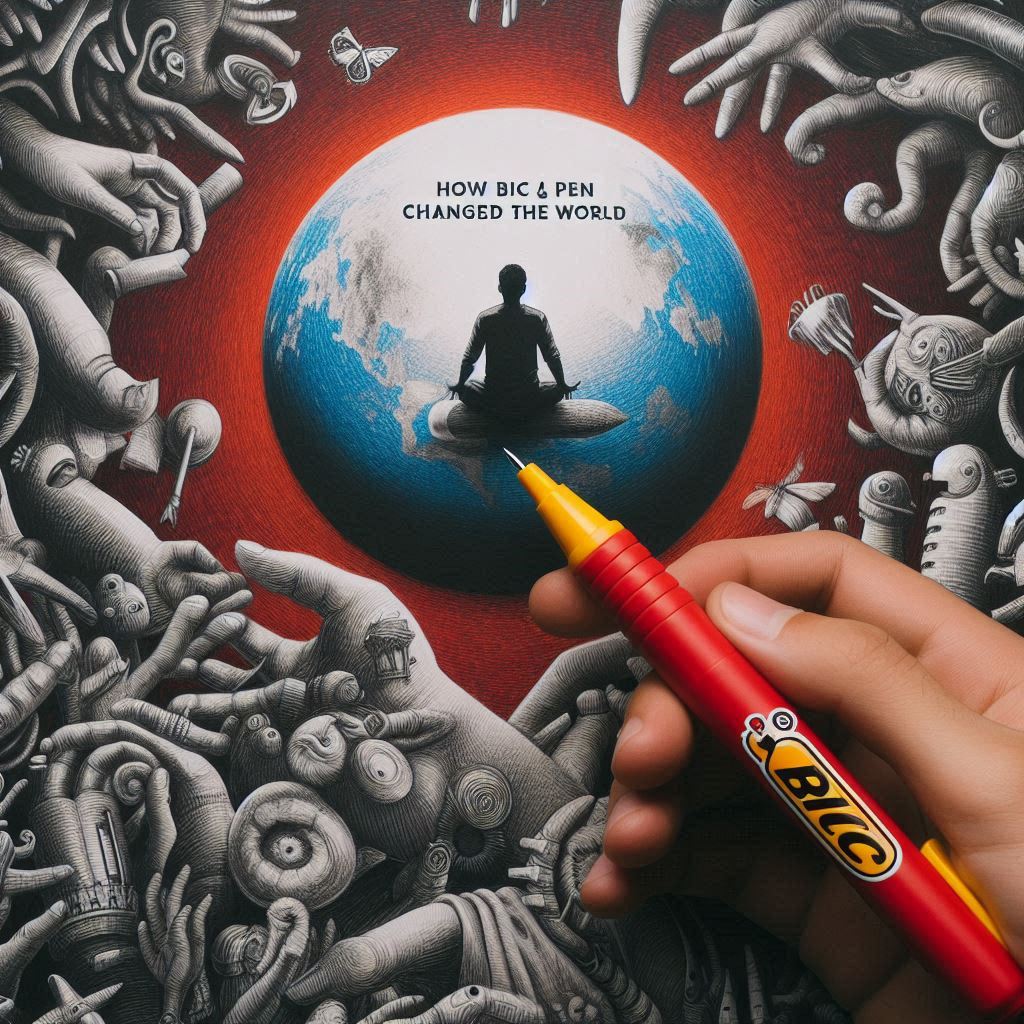This website uses cookies so that we can provide you with the best user experience possible. Cookie information is stored in your browser and performs functions such as recognising you when you return to our website and helping our team to understand which sections of the website you find most interesting and useful.

The Fascinating History of BIC, the Company Behind the Pen

Writing lies at the foundation of modern society. It is a technology that few of us think about, and today we will explore the company behind the pen, BIC.
The Evolution of Writing Instruments
Before the advent of metal pens, the western world’s writing instrument of choice was the quill. Finding bird feathers wasn’t very hard and ever since 600 AD, that’s how most writing was done. Once the Industrial Revolution got underway, improved metallurgy and mass production techniques resulted in the dip pen. It was essentially a metal nib mounted on a handle; it could barely hold more ink than a quill, and its practical use was about the same.
The Rise of Fountain Pens
The first truly practical pens appeared at the end of the 19th century. They are what we call fountain pens, and the innovation behind them was that they had a reservoir of ink inside. The first commercially successful fountain pens were built in 1884 by Lewis Waterman.
He was originally an insurance broker, but one day when signing a very important contract, the prototype fountain pen he had bought for the occasion broke and leaked ink on the whole document.
This accident eventually resulted in the deal getting canceled and Waterman losing his job. Making the best out of a bad situation, Waterman decided to build a better fountain pen, and it was his design that truly made fountain pens the dominant writing instrument of the next half-century.
The Invention of the Ballpoint Pen
It wouldn’t be until the 1930s that fountain pens would finally meet their match. The man responsible for that was Laszlo Biro, a Hungarian journalist. He had noticed that the ink used in newspaper printing dried quickly, leaving the paper dry and smudge-free.
When he tried using the same ink in a fountain pen, however, it wouldn’t flow into the tip because it was too viscous. After seven years of trial and error, Laszlo developed a new tip for his pen, consisting of a ball that could freely rotate in a socket. As the ball ran along the paper, it would siphon ink from an internal cartridge and spread it out evenly. What Laszlo had created was the ballpoint pen.
Challenges and Triumphs
But the timing of his invention was a bit unlucky. As a Hungarian Jew, Laszlo was well aware of what was happening in Germany, and so in 1938, he packed his bags and moved to Paris. While there, he got the lucky chance of meeting the president of Argentina, Agustín Pedro Justo. He was so impressed by the ballpoint pen that he told Laszlo to emigrate to Argentina, which of course he did as he wanted to be as far away from Germany as possible.
Marcel Bich and the Birth of BIC
Once in Argentina, Laszlo set up a company for his pens, and by 1943, he was selling them to His Majesty’s Royal Air Force in the UK. This first generation of ballpoint pens wasn’t perfect. The metal case was prone to leaking, and the ink would often clog.
Most of Laszlo’s non-government clients ended up returning their pens, which drove his company to the brink of bankruptcy. To keep the company afloat, Laszlo resorted to selling the rights to his pen in Europe and in the US.
Acquiring the Patent
The man who bought the European rights to the ballpoint pen was Frenchman Baron Marcel Bich. He had entered the pen business in 1945 when he bought a damaged factory on the outskirts of Paris and used it to start making fountain pens. Marcel fell in love with the ballpoint pen, and in 1950, when he heard that Laszlo was selling the patent, he threw $2 million at Laszlo to get it.
With the patent in hand, Marcel used his considerable resources to acquire plastic and precision stainless steel technology from Switzerland. Now, keep in mind, plastic was still a very new invention in the early 1950s, and it had only been commercialized a few years prior.
The Success of BIC Cristal
The shaping machines Marcel bought were cutting edge for their time, capable of shaping metal down to 10 micrometers. The design of Marcel’s pens was as simplistic as it was brilliant. The pen’s barrel was shaped similarly to a pencil, making it very hard to roll off a table, and since it was made of transparent polystyrene, it was easy to see when you were running out of ink.
What truly made Marcel’s endeavor successful, however, was his understanding of economies of scale. You see, the pens that Laszlo sold were very expensive, and although they were vastly superior to fountain pens, it was very hard to justify spending the equivalent of one week’s wage for one pen. Marcel, however, streamlined his production and bought everything in bulk, allowing him to sell his pens for a fraction of the cost—only 50 centimes, the equivalent of 18 cents in the US.
Global Expansion
Marcel’s initial plan was to sell the pens under his family name, but once people told him how English speakers were pronouncing it, he decided to drop the H. Thus, in 1950, he established Société BIC and began flooding France with his trademark pen, which he called the BIC Cristal.
Unsurprisingly, the pen was an instant hit, surpassing everything on the market both in terms of quality and price. Within three years, Marcel was selling 40 million pens annually. He could barely keep up with the rising demand, and so he started opening subsidiaries left and right. By 1954, he was operating across Western Europe, and just two years later, his pens were also sold in South America and Africa.
Entering the US Market
Marcel didn’t enter the US market until 1958, and he did so in a very interesting fashion. Remember our friend Lewis Waterman? He was the insurance broker who started making fountain pens in the late 1880s. The company he had started was now the largest manufacturer of fountain pens in the US, but the ballpoint revolution had left them near bankruptcy.
To gain a foothold in the States, Marcel offered to buy Waterman, and he did so for $1 million. He repurposed most of Waterman’s factories to make ballpoint pens and kept the fountain pen division as a luxury brand, which is still around to this day, although as a separate entity.
The BIC Boy and Technological Advances
In 1961, French artist Raymond Savignac created the BIC Boy, which has remained a part of the company’s logo ever since. That year, the company replaced their stainless steel ballpoints with much harder tungsten carbide, which they still use today.
By the end of the 1960s, BIC pens were sold on every inhabited continent, and Marcel was looking for other products to add to his arsenal. In line with his philosophy, he needed something cheap and disposable that people would use every day. A pocket lighter turned out to be the perfect candidate.
Expanding to Lighters and Razors
Much like with the ballpoint pen, Marcel’s affordable lighter outperformed all available alternatives and was capable of producing 3,000 flames over its lifetime. Its release in 1973 was met with universal acclaim, and today lighter sales make up over 35% of the company’s revenue. Just two years later, Marcel found another market he could conquer.
In what was essentially a declaration of war on Gillette, BIC released a disposable safety razor in 1975. They heavily undercut Gillette and have been a thorn in their sides ever since. Although BIC has had a hard time outcompeting Gillette, razor sales are still a big chunk of their business, making up almost 24% of their sales today.
Other Ventures and Challenges
As a lifetime watersports enthusiast, Marcel established BIC Sport in 1979, which made windsurf equipment and sailboards. Although BIC Sport is still around today, it is a very minor part of the company and hasn’t been very successful.
Marcel’s future endeavors, however, would fare even worse. A few months after starting BIC Sport, Marcel decided to enter the clothing market by purchasing Guy Laroche from its founder for $10 million.
At first, the deal seemed great, but with the legendary fashion designer in failing health and incapable of making new designs, the fashion company soon became unprofitable. When Guy himself died in 1989, things became even worse. After a series of failed successors, Marcel was also getting pretty old at that point and was starting to make mistakes, like when he tried to enter the perfume market in 1989 and failed so miserably that he scrapped the whole line of perfumes just two years later.
Continuing the Legacy
Marcel died in 1994, and his son Bruno took up the reins to fix the company. His first move was to strengthen BIC’s hold on the pen business by buying Wite-Out and Tipp-Ex, the two largest correction brands in the world. He sold the unprofitable Guy Laroche in 2001, and it eventually ended up in the hands of a Chinese company.
Since then, BIC has tried to venture into the realm of consumer electronics by selling mobile phones, tablets, and hydrogen fuel cells, but the results have been lackluster at best. Even today, their most successful products are Marcel’s original trifecta: pens, razors, and lighters. In fact, just in 2016, BIC sold 7 billion pens, 2.5 billion razors, and 1.5 billion lighters.
If time has shown anything, it’s that the company’s success lies in the simplicity of their products, and judging by their failure to profit from anything more complex than a ballpoint pen, they would do well to continue honoring Marcel’s legacy.
Thanks for reading! If you enjoyed the history of BIC, feel free to subscribe for more and to check out the full Behind the Business playlist for the interesting stories of other big companies. Once again, thanks a lot for reading, and as always, stay smart.


